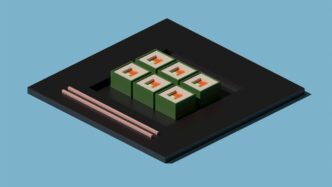Thinking about the future of computing? It’s a wild ride, and quantum computers are definitely a big part of that story. These aren’t your average laptops; they work on totally different principles, using quantum mechanics to solve problems that are just too much for regular computers. Lots of companies are jumping into this space, trying to build these powerful machines. We’re talking about some big names and some smaller, specialized outfits, all pushing the boundaries. It’s a fast-moving field, so keeping track of who’s doing what can be a challenge. We’ve put together a look at some of the leading quantum computing companies that are really making waves as we head into 2025.
Key Takeaways
- IBM and Google are pushing ahead with superconducting qubits, aiming for larger and more capable processors.
- Microsoft is focusing on topological qubits, believing they’re key to scalable, fault-tolerant systems.
- Companies like IonQ and Quantinuum are using trapped-ion technology, showing progress in qubit stability and control.
- D-Wave Systems continues to offer quantum annealing solutions, while others like PsiQuantum and Xanadu are exploring photonic approaches.
- The field is rapidly advancing with significant investments, but challenges like error correction and scalability remain key areas of focus for all leading quantum computing companies.
1. IBM
IBM has been a major player in the quantum computing scene for a while now, really pushing the boundaries with their superconducting qubit technology. They’ve been steadily building bigger and better quantum processors, which is pretty impressive. Think about it: they went from their 65-qubit Hummingbird processor back in 2020 to the 127-qubit Eagle processor in 2021, and then the 433-qubit Osprey in 2022. They even announced a 1,121-qubit processor called Condor. It’s like they’re in a race to see how many qubits they can pack in there!
Beyond just the raw qubit count, IBM is also focused on making these systems usable. They have their IBM Quantum System One, which was one of the first commercially available quantum computers designed for businesses to actually use. Now they’re working on Quantum System Two, which is all about modularity and connecting multiple processors. This modular approach is a big deal because it’s a key step towards building those much-talked-about error-corrected quantum computers.
What’s really interesting is their commitment to making quantum accessible. They have the IBM Quantum Experience, a cloud platform where people can run experiments on their actual quantum hardware. Plus, their Qiskit software development kit is open-source and has become a go-to tool for anyone wanting to learn or build quantum applications. They’ve even got this big network of partners, over 170 of them, all working together. It feels like IBM is really trying to bring quantum computing out of the lab and into the real world, and they’re pretty open about sharing their progress, which is nice to see.
2. Google
Google’s Quantum AI division is really pushing the boundaries in the quantum computing space, especially with their work on superconducting qubits. They’re not just building the hardware; they’re also deep into developing the algorithms that will actually use these powerful machines. Think about it – they’re trying to make quantum computers useful for things like artificial intelligence, figuring out complex problems, and even making encryption stronger.
It’s a whole package deal: hardware, software, and the smarts to run it all. They’ve had some pretty big moments, too. Remember when their Sycamore processor supposedly did something a regular supercomputer would take ages to do? That was Google showing off what these quantum machines are capable of. They’ve also got processors like Bristlecone and the more recent Willow chip, which is all about tackling those pesky errors that quantum computers are prone to. It’s a tough problem, but Willow is designed to handle it better, which means more reliable results for things like chemistry simulations or figuring out new materials. They’re aiming for a useful, error-corrected quantum computer by 2029, which is pretty ambitious, but they’ve already hit some major milestones on the way there.
3. Microsoft
Microsoft is really going all-in on quantum computing, and it’s pretty interesting to see their approach. They’re not just building hardware; they’ve got this whole ecosystem going with their Azure Quantum platform. Think of it as a central hub where you can actually access and play around with quantum computers from different companies, like IonQ and Quantinuum. It’s a smart move because it lets people experiment without needing their own super-expensive quantum setup.
What really sets Microsoft apart, though, is their focus on something called topological qubits. The idea here is that these qubits are naturally more stable and less prone to errors than the usual kind. It’s a really tough technical challenge, but if they pull it off, it could be a game-changer for building bigger, more reliable quantum computers. They even announced their Majorana 1 chip, which is supposed to be the first processor using these topological qubits. It’s still early days, and they haven’t got their own fully working quantum computer out there yet, but their strategy of combining cloud access, developer tools like the Q# language, and this fundamental hardware research makes them a serious contender.
Here’s a quick look at their strategy:
- Cloud Platform: Azure Quantum provides access to various quantum hardware and quantum-inspired services.
- Hardware Focus: Developing topological qubits for more stable and scalable quantum systems.
- Software Tools: Creating a full quantum software stack, including the Q# programming language and the Quantum Development Kit (QDK).
- Partnerships: Collaborating with other quantum hardware providers to broaden access and accelerate development.
4. Rigetti Computing
Rigetti Computing is one of the companies really pushing the boundaries with their superconducting quantum computers. They’ve been around since 2013 and were actually one of the first startups to build these complete gate-model quantum systems. What’s neat about Rigetti is how they’ve integrated their hardware and software, offering what they call a "full-stack solution." This means you can get pretty low-latency access to their own hardware through their cloud, which is handy for those quick hybrid computing tasks.
They’ve got a roadmap aiming for systems with over 1,000 qubits by 2025, and they’re working on error mitigation too. Rigetti’s Aspen-M machine, which came out in 2021, was pretty interesting because it was the first commercial device to use a multi-chip module, connecting two 40-qubit dies. It’s a bit of a race out there, but Rigetti is trying to stand out by making sure their hardware and software work together really well.
Here’s a look at some of their recent developments:
- Focus on Scalability: Rigetti is actively developing multi-chip architectures to increase qubit counts, with a goal of over 1,000 qubits by 2025.
- Hybrid Quantum-Classical Approach: They provide a programming environment that blends quantum and classical computing, allowing for faster iterations on complex problems.
- Industry Partnerships: Rigetti has collaborated with organizations like DARPA, NASA, and the Department of Energy to explore various applications, from machine learning to climate modeling.
5. D-Wave Systems
D-Wave Systems has been in the quantum game for a while, actually. Founded way back in 1999, they were the first company to actually sell a quantum computer, back in 2011. What makes D-Wave a bit different is their focus on quantum annealing. Think of it like this: instead of trying to solve problems with traditional bits or even gate-based qubits, they use quantum annealing to find the best possible solution to really tough optimization problems. These are the kinds of issues you see in logistics, figuring out the most efficient delivery routes, or in finance, like managing investment portfolios.
Their latest system, the Advantage, is pretty impressive, boasting over 5,000 qubits. They’ve also been working on improving things, like adding a fast-anneal feature that speeds up their systems. Plus, they’ve got this program called Leap Quantum LaunchPad, which gives people a chance to try out their technology for free for a few months. It’s a smart move to get more people familiar with what they’re doing. D-Wave is really pushing the idea that quantum computing can solve real-world business problems right now.
6. IonQ
IonQ is really making waves in the quantum computing scene. They’re all about using trapped-ion technology, which basically means they use individual atoms, suspended in a vacuum, and zap them with lasers to do their quantum thing. This method is pretty neat because it tends to give them really stable qubits with long coherence times, which is super important for getting accurate results.
They were one of the first companies focused solely on quantum computing to go public, which was a big deal back in 2021. IonQ doesn’t just focus on the hardware, though; they’ve also got a whole software setup to go with it. You can actually access their machines through big cloud providers like Amazon, Microsoft, and Google.
IonQ has been rolling out different models over the years:
- IonQ Harmony: This was their first machine available to the public, with 11 qubits. It’s not really used anymore, though.
- IonQ Aria: Came out in 2022 with 25 qubits. It’s a pretty solid machine that you can access through the cloud.
- IonQ Forte: This is their latest, released in 2023, boasting 36 qubits. What’s cool about Forte is its use of new tech that lets them control the lasers with more precision, aiming for better performance.
IonQ’s goal is to build bigger, networked systems with hundreds of qubits that can all talk to each other. They’ve raised a good chunk of money and hit some important tech goals, putting them right at the front of trying to make quantum computers actually useful for businesses.
7. Quantinuum
Quantinuum is a pretty interesting company, formed by the folks at Cambridge Quantum Computing and Honeywell Quantum Solutions. They’re really focused on trapped-ion quantum computers, which is a bit different from some other approaches. What’s neat about their setup is that the qubits can all talk to each other directly, which they say helps make for really high-quality quantum states. This all-to-all connectivity is a big deal for tackling tough problems in areas like quantum chemistry and even cybersecurity.
They’ve been hitting some impressive numbers, too. Back in April 2024, their H-Series trapped-ion computers managed to reach a quantum volume of over a million. That’s a pretty big number and shows they’re making real progress. They’ve got a roadmap to deliver a fully fault-tolerant quantum computer, called Apollo, by 2030. It’s a big goal, but they seem to be pushing hard to get there. It’s cool to see how they’re combining their hardware smarts with software development, aiming to get the best performance out of their systems. They’re definitely one to watch as things develop in the quantum space, especially with their plans for a fault-tolerant quantum computer.
8. Intel
Intel, the semiconductor giant, is taking a rather unique path in the quantum computing race. Instead of focusing on exotic qubit types, they’re leaning heavily on what they know best: silicon. This means they’re working on spin qubits, which are basically electrons trapped in tiny silicon structures. The big idea here is that if you can make computer chips, you can probably make quantum chips using similar methods. It’s a smart play because it could make manufacturing quantum computers much easier and cheaper down the line.
They’ve already put out a few chips, like the Tangle Lake, which was a 49-qubit superconducting processor, and more recently, the Tunnel Falls chip, a 12-qubit silicon chip. These are still early days, mind you, but the progress is steady. Intel is also developing specialized control chips, like Horse Ridge, designed to work at super cold temperatures, which is necessary for quantum computers to function. Intel’s deep roots in silicon manufacturing give them a potential advantage in scaling up quantum hardware. They’re not just researching; they’re building with an eye toward mass production, which is something not everyone in this field is doing. It’s a long game, but their approach could really change how quantum computers are made if it pans out. You can see some of their work on silicon quantum processors.
9. Amazon Web Services
Amazon Web Services, or AWS as most people call it, is really making waves in the quantum computing scene. They’ve got this service called Amazon Braket, which is basically a cloud platform. Think of it as a central hub where you can get your hands on quantum computers and tools from a bunch of different companies, like D-Wave and IonQ. It’s a pretty neat way to try out different quantum hardware without having to buy your own super expensive setup. You just pay for what you use, which makes it way more accessible.
AWS isn’t just a middleman, though. They’re also doing their own research. Back in February 2025, they showed off their first quantum chip, named Ocelot. This chip is still a prototype, but it’s designed to help cut down on quantum errors, which is a huge hurdle in this field. They’re using a new approach that combines different technologies to try and make things more stable. It’s still early days for AWS building their own full-blown quantum computer, but they’re definitely putting in the work and making some interesting progress.
10. NVIDIA
NVIDIA, a name synonymous with graphics processing units (GPUs) and artificial intelligence, is also making significant moves in the quantum computing space. While CEO Jensen Huang has offered a more measured outlook, suggesting truly practical quantum computers are still 15 to 30 years away, the company isn’t waiting around. They’re actively building the infrastructure and software to support this future.
In March 2025, NVIDIA launched the NVIDIA Accelerated Quantum Research Center (NVAQC) in Boston. This center is all about developing new quantum computing architectures and algorithms that can work hand-in-hand with their powerful AI supercomputers. Think of it as creating a bridge between today’s advanced computing and tomorrow’s quantum capabilities.
NVIDIA’s strategy heavily relies on its existing strengths. They’ve released cuQuantum, a software development kit that includes libraries designed to speed up the simulation of quantum circuits using GPUs. This means researchers can simulate more qubits on classical supercomputers, which is a big help for designing and testing quantum algorithms. They’ve also introduced the NVIDIA Quantum Optimized Device Architecture (QODA), a platform that aims to make programming both quantum and classical resources much simpler.
Here’s a look at some of NVIDIA’s key contributions:
- cuQuantum SDK: Libraries like cuStateVec and cuTensorNet that accelerate quantum circuit simulations on GPUs.
- QODA: A programming platform for unified quantum and classical computing resources.
- DGX Quantum: Introduced in March 2023, this is the first GPU-accelerated quantum computing system, combining NVIDIA’s Grace Hopper Superchip with Quantum Machines’ OPX control platform for low-latency, high-performance quantum-classical research.
NVIDIA is essentially positioning itself as a key enabler, providing the high-performance computing backbone and software tools that researchers and developers will need as quantum computing matures. They’re not just building hardware; they’re building the ecosystem.
11. PsiQuantum

PsiQuantum is taking a really interesting path in the quantum computing race. Instead of focusing on the smaller, more experimental machines you see from some other companies, they’re aiming straight for the big leagues: a million-qubit, fault-tolerant quantum computer. Their whole strategy hinges on using light – specifically, photons – to do the quantum calculations. Think of it like using tiny light pulses zipping through silicon chips to represent and manipulate quantum information.
This approach, using photonics, is pretty bold. The idea is that by piggybacking on existing semiconductor manufacturing techniques, they can scale up much faster and more affordably than companies using more specialized hardware. They’ve been pretty quiet about their progress, but they’ve managed to raise a significant amount of money, over $650 million, which shows a lot of people believe in their vision. They’ve even partnered with GlobalFoundries, a big chip maker, to get their custom chips produced.
What’s the big deal about a million qubits? Well, the folks at PsiQuantum believe that’s the number needed to really tackle some of the hardest problems out there, like discovering new materials or designing complex molecules for medicine. They’re not just talking about it, either; they’re building the actual components, like specialized detectors and the chips themselves. Their target is to have a working, error-corrected machine ready by around 2027. It’s a massive undertaking, but if they pull it off, it could really change how we approach scientific research and problem-solving. You can get a sense of the overall progress in the field by looking at the Quantum Technology Monitor 2025.
12. Xanadu
Xanadu is a Canadian company that’s really pushing the boundaries with photonic quantum computing. Instead of using the usual superconducting circuits or trapped ions, they’re working with light. Think of tiny pulses of light, or photons, traveling through optical fibers and circuits to do the actual computing. It’s a different approach, and they believe it could lead to more scalable and efficient quantum machines, especially since their systems can operate at room temperature, which is a big deal.
One of their big achievements was with a processor called Borealis. Back in 2022, they used it to tackle a problem called Gaussian boson sampling. They managed to get a massive number of samples, and the claim was that it would take the best classical computers about 9,000 years to do the same job. That was a pretty significant moment for photonic quantum computing. They also have a really popular open-source software library called PennyLane. It’s become a go-to tool for people working on quantum machine learning and quantum chemistry, making it easier to connect quantum hardware with regular machine learning tools like TensorFlow. This has helped them build a strong community around their work.
Here’s a quick look at some of their hardware:
- Borealis: This is their photonic quantum computer that uses squeezed light. It’s been used for those quantum advantage experiments and is available through cloud platforms.
- Aurora: This is described as the world’s first universal photonic quantum computer. It’s a bit more modular, with different parts that can work together, and it uses a lot of fiber optics – like 13 kilometers of it!
13. QuEra Computing
QuEra Computing is really making waves in the quantum world, especially with their focus on neutral-atom technology. They’re based out of Boston and came out of some pretty impressive research from Harvard and MIT. What’s cool about their approach is how they’re building quantum computers that are designed to scale up, which is a big deal for actually using this tech for real problems.
Their first machine, called Aquila, has 256 qubits. It’s not your typical quantum computer; it works in an analog mode. Think of it like using lasers to trap and arrange tiny atoms in a vacuum. This setup lets them do some pretty complex simulations. QuEra was actually the first company to get a neutral-atom system onto a major cloud platform, Amazon Braket, which is a huge step for making this technology more accessible. They’ve also managed to show some pretty advanced stuff, like area-law entanglement on a big 2D array of qubits. That’s a pretty significant milestone for quantum simulation.
What’s next for QuEra? Well, they’ve got big plans. They’re aiming to move from these analog simulators to fully digital, error-correcting quantum computers. Plus, they announced plans to build a massive quantum computer with a million qubits in Chicago. They’ve also secured some serious funding, which shows a lot of confidence in their direction. It seems like they’re really pushing the boundaries of what’s possible with neutral-atom systems.
14. Pasqal
Pasqal, a French company, is making waves in the quantum computing scene with its focus on neutral-atom technology. They’re building quantum computers that use lasers to trap and control atoms, which is a bit different from some of the other approaches out there. Think of it like using tiny laser tweezers to hold and arrange atoms in specific patterns. This method has some neat advantages, like being able to connect all the atoms easily.
Pasqal has been busy scaling up its systems. They’ve already got processors with over 100 atomic qubits and are aiming for 1,000 in the next few years. The company is really pushing to make these machines useful for real-world problems, especially in areas like machine learning and optimization. They’re also working on making their systems more robust and easier to integrate with existing business operations through cloud platforms.
Here’s a look at some of their recent progress and future plans:
- Scaling Up: Pasqal’s roadmap includes moving from over 100 qubits now to a target of 10,000 qubits by 2026. They’re putting a lot of effort into making these systems fault-tolerant, which means they can handle errors better.
- Industrial Focus: The company is really geared towards getting their quantum computers into production environments. They expect to see hardware-accelerated algorithms start being used in business settings by 2025.
- Partnerships: Pasqal has teamed up with big names like BMW for materials discovery and Crédit Agricole for financial applications, showing that industry is taking notice.
- European Leadership: They were the first quantum hardware startup in Europe to deliver a programmable 100-qubit quantum simulator, which is a pretty big deal.
15. Riverlane
Riverlane is a UK-based company that’s really focused on the software side of quantum computing. Think of them as building the operating system for quantum computers. Their main product, Deltaflow.OS, is designed to work with all sorts of different quantum hardware, acting as a bridge to make things run smoothly. They’re particularly good at tackling quantum error correction, which is a huge hurdle for making quantum computers reliable.
Riverlane aims to make unreliable qubits behave reliably through software. They’ve even led efforts that set world records for quantum memory time using error-correcting codes. It’s pretty impressive stuff. They’re working with places like the UK’s National Quantum Computing Centre to get different quantum devices talking to each other.
They’re also involved in research for quantum simulation, especially for materials science. The big idea is that when quantum hardware gets much bigger, with thousands of qubits, you’ll need a smart software layer to manage everything – like keeping track of errors and figuring out the best way to run calculations. Riverlane wants to be that layer. They’ve secured significant contracts, including one with NIST in the U.S. for an error correction stack. It feels like they’re trying to be the Microsoft of the quantum computing world, providing the core software that everyone else will build upon. It’s a big goal, but they seem to have the right ideas and support to get there. Finding good engineering talent is key for companies like this, and Riverlane is definitely a place where those skilled individuals are needed to shape the quantum landscape Together we engineer.
Riverlane has raised about $75 million, with a valuation around $400 million.
The Road Ahead
So, we’ve looked at some of the big players making waves in quantum computing. It’s pretty wild to think about what these companies are building. From IBM’s steady progress with superconducting qubits to Google’s focus on error correction with chips like Willow, and Microsoft’s bet on topological qubits, everyone seems to have their own approach. Companies like IonQ and Quantinuum are pushing forward with trapped ions, while others like D-Wave are exploring quantum annealing. It’s clear that getting these machines to work reliably and at a large scale is still a huge hurdle. We’re talking about super cold temperatures, tricky error correction, and software that’s still pretty new. But the potential is massive, with promises of breakthroughs in everything from medicine to materials science. It’s a fast-moving field, and what we’ve covered today is just a snapshot, but it gives you a good idea of the exciting, and challenging, journey ahead for quantum computing.
Frequently Asked Questions
What exactly is a quantum computer and why is it special?
Quantum computers use special bits called qubits. Unlike regular computer bits that are either 0 or 1, qubits can be both at the same time! This amazing ability, called superposition, lets them solve certain really tricky problems much, much faster than even the best regular computers.
How do quantum computers solve problems faster than regular computers?
Think of it like this: regular computers work step-by-step, like following a recipe. Quantum computers can try out many different ways to solve a problem all at once, like tasting all the ingredients at the same time to find the perfect flavor. This makes them super powerful for tasks like discovering new medicines, creating new materials, or making financial models.
What are the different ways companies are building quantum computers?
Many companies are working on building these amazing machines. Some are focusing on using tiny particles called ions that are trapped by lasers, while others are using special circuits that need to be super cold. Each company has its own unique way of building these computers, like different types of engines in cars.
What are the main challenges in making quantum computers work well?
The biggest hurdles are making the qubits stable and fixing errors that happen easily. It’s like trying to build a very delicate structure that can easily get messed up by a slight breeze. Companies are working hard to make their quantum computers more reliable and easier to use.
When will quantum computers be powerful enough to change the world?
While some early quantum computers are already being used for specific tasks, the really powerful ones that can solve huge global problems are still a bit in the future. Experts think we might see them become truly useful for many industries in the next 10 to 20 years.
How can people start using quantum computers today?
Companies are making quantum computers accessible through the internet, kind of like how you can use powerful software on your phone without owning a supercomputer. This allows researchers and businesses to try out quantum computing for their own problems without needing to build their own machines.














